ABSTRACT
The aim of this paper was to analyse the cleanliness of root canals prepared with the use of Revo-S, ProTaper Next and Twisted Files Adaptive instruments. After preparation and thorough irrigation, the roots were notched transversally and split into three even parts. The cross-sections were then analysed using a dental microscope. Irrespective of the shape of a given cross-section and of the part of a dental root, the best results were recorded after the application of Twisted Files Adaptive. In the apical section of the examined canals, the best results were obtained with ProTaper Next instruments. In the middle and coronal part, Twisted Files Adaptive instruments demonstrated the highest cleaning efficiency. Regardless of the applied system of instruments, no residues or impurities were found in canals with round cross-sections. In teeth with oval and irregular cross-sections, a higher degree of cleanliness was observed after canal preparation using Twisted Files Adaptive.
A modern endodontic therapy is a complicated procedure that offers high predictability. The effectiveness of such treatment depends mainly on decontaminating, cleaning and tight sealing of all spaces of an endodontic system.1-4 Even in the case of vital treatment, when an infection in root canals is not confirmed, it is required to clean the entire area of canals thoroughly, particularly from organic residues that could – in the future – constitute a biological niche and medium for microorganisms. An endodontic system is cleaned and prepared for filling by mechanical and chemical preparation. Mechanical preparation is aimed to remove infected dentin, pulp, and material from a root canal, as well as prepare paths for antiseptic liquids and to calibrate the space of a given root canal before it is filled.2–4
The application of nickel-titanium rotary instruments has become a standard procedure in contemporary endodontics. In relation to traditional hand instruments, rotary instruments enable to work faster and facilitate preparation of root canals in accordance with their original axis.2-4 There is, however, a risk of breaking an instrument when preparing a narrow and/or curved root canal. In order to improve elasticity and resistance to tension, numerous modifications have been introduced in the design engineering and production of nickel-titanium instruments.4-7
In recent years, many new and innovative products have been launched. A tool of an asymmetrical cross-section is one of the examples of creative designing of instruments. In case of such instruments the cross-section is not located centrally in the cut out circle, but at a certain distance from the axis of rotations. When rotating, such an instrument machines a canal with only one of its three (or two of four) edges and the remaining edges have no contact with the canal wall. Owing to that, the diameter of a circle cut out in the root canal is greater than the diameter of the instrument’s cross-section. This way, instrument tension and resistance of machining are reduced. The remaining and non-machining part of the instrument’s cross-section is used for evacuation of filings and residues created as a result of widening the root canal.
TABLE 1. Level of canal system cleanliness after preparation of the root canals using Revo-S system, depending on the part of the root and the shape of cross-sections.
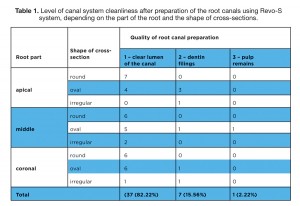
Revo-S (Micro-Mega, France) and ProTaper Next (Dentsply Maillefer, Switzerland) are examples of such systems. According to the manufacturer of Revo-S, three instruments (marked as SC1, SC2 and SU), whose size at the apex totals 25 according to ISO, are sufficient to prepare root canals. The first and last instrument is characterised by convergence of 6% and an asymmetrically moved cross-section. The second instrument among the ones mentioned above, with convergence of 4%, has a symmetrical cross-section. In wide canals, the manufacturer recommends additional preparation of the apical part with asymmetrical instruments of convergence totalling 6%, with sizes 30, 35 or even 40 according to ISO.
ProTaper Next is the second system of instruments with an asymmetrically moved cross-section. As opposed to Revo-S, ProTaper Next instruments have a different shape of cross-section. The cross-section of Revo-S instruments resembles an equilateral triangle with concavo-convex sidewalls. ProTaper Next, on the other hand, has the cross-section shaped like a rectangle. ProTaper Next instruments are made of a modified nickel-titanium alloy – M-wire. Adequate thermal processing of the NiTi alloy improves its elasticity and resistance in comparison to a standard alloy.4,6,7 In a standard sequence of instruments, the manufacturer also recommends root canal preparation to size 25 according to ISO. For this purpose, two instruments are used: X1 (17/04 acc. to ISO) and X2 (25/06 acc. to ISO). In case of wider canals, X3 (30/07 acc. to ISO) and X4 (40/06 acc. to ISO) instruments are recommended. Additionally, the manufacturer advises use of the SX instrument (19/04–10 acc. to ISO) from the Pro Taper Universal system (Dentsply) to carry out initial widening of the coronal part of a root canal (the so-called preflaring).
TABLE 2. Level of canal system cleanliness after preparation of the root canals using ProTaper Next system, depending on the part of the root and the shape of cross-sections.

Modified thermal treatment combined with simultaneous rotation is a completely different method of making instruments as compared to the aforementioned systems. Twisted Files (SybronEndo, USA) are examples of such instruments. While standard nickel-titanium instruments are cut out from a round wire, Twisted Files are made from a wire of a triangular cross-section, which is twisted spirally in the process of alternating heating and cooling to appropriate temperatures. The instruments manufactured using this method are more elastic and resistant.6 Twisted Files Adaptive instruments, which allow not only a rotary, but also an adaptive reciprocating motion (the so-called adaptive motion), have been launched recently. A micro motor dedicated to these instruments is programmed with a special algorithm, which changes the rotary motion of a given instrument into reciprocating motion (alternately laevorotatory and dextrorotatory) when load during rotation increases. In the case of undisturbed operation, the instrument works in short rotation cycles (600 degrees to the right). If the motor detects increased resistance during instrument’s rotation, it changes the motion to reciprocating: 370 degree to the right and 50 degrees to the left.
TABLE 3. Level of canal system cleanliness after preparation of the root canals using Twisted Files Adaptive instruments, depending on the part of the root and the shape of cross-sections.
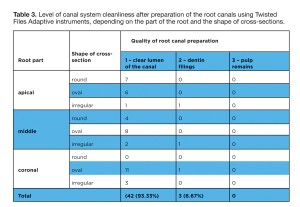
The aforementioned instruments have been available for sale for a relatively short time and the number of available publications on their operation and efficiency is insignificant. Therefore, it is purposeful to carry out this comparison, which focuses on the efficiency of the aforementioned instruments in the preparation of root canals with diverse types of cross-sections.
Aim
The aim of this paper was to compare the level of cleanliness of prepared root canals characterised by diverse shapes of cross-sections using three systems of nickel-titanium
instruments.
Materials and methods
The following instruments were used:
• Revo-S – rotary motion,
• ProTaper Next – rotary motion,
• Twisted Files Adaptive – rotary and reciprocating adaptive motion.
Forty-five extracted human teeth were used for the experiment. One-canal roots with an irregular shape of the root canal and I & II degree curvature according to Schneider were selected, i.e. second premolars, palatal roots of upper molars and distal roots of lower molars. Having cleaned the teeth, separation at the level of anatomical neck was conducted using a thin diamond burr, with constant water and air cooling. The working length was set using type C files (10 according to ISO, VDW, Germany), subtracting 0.5 mm from the anatomical foramen. Afterwards, the canals were initially widened with type C files to size 15 according to ISO (VDW). Then, the roots were divided randomly into 3 groups (n = 15) based on the applied system of nickel-titanium instruments:
• group 1 – Revo-S,
• group 2 – ProTaper Next,
• group 3 – Twisted File Adaptive.
In groups 1 and 2, the canals were prepared using an EndoMate TC2 micro motor (NSK, Japan), set at 350 revolutions per minute and with torque totalling 1.4 Ncm. In group 3, an Element Motor (SybronEndo) was used, set at the dedicated “Adaptive Motion” program. Before introduction into a root canal, every tool was covered with a small amount of FileCare lubricant (VDW). Between consecutive instruments, the root canals were irrigated thoroughly with 5.25% sodium hypochlorite. Brushing movements were made with the instruments, in accordance with the anatomy and oval of the root canals. In all the groups, the following sequence of instruments was implemented based on the manufacturers’ recommendations:
Group 1 (Revo-S):
SC1 (white) – 25/06 – ⅔ of the working length,
SC2 (yellow) – 25/04 – full working length,
SU (red) – 25/06 – full working length,
AS (blue) – 30/06 – full working length;
Group 2 (ProTaper Next):
X1 (yellow) – 17/04 – full working length,
X2 (red) – 25/06 – full working length,
X3 (blue) – 30/07 – full working length;
Group 3 (Twisted Files Adaptive):
SM1 (green) – 20/04 – full working length,
SM2 (yellow) – 25/06 – full working length,
SM3 (red) – 35/04 – full working length.
After mechanical preparation, the root canals in all the groups were irrigated based on the protocol below:
• 5.25% sodium hypochlorite – 1 minute, 5 ml/canal,
• 40% citric acid – 1 minute, 5 ml/canal,
• 5.25% sodium hypochlorite – 1 minute, 5 ml/canal,
• 40% citric acid – 1 minute, 5 ml/canal,
• 5.25% sodium hypochlorite – 2 minutes, 10 ml/canal.
After chemical and mechanical preparation, the root canals were rinsed with distilled water (5 ml/canal). After transversal notching of the roots using a separator with both-sided diamond grit, and with continuous water and air-cooling, the roots were split into three even parts (apical, middle and coronal). Every cross-section was observed under a Zeiss OPMI Pico microscope (Karl Zeiss, Germany) in magnification (X10 and X20). Photographs were taken with a Canon D650 camera (Canon, Japan), mounted to a 50/50 beam-splitter. The authors’ own scale, applied in previous publications, was used to evaluate the level of cleanliness of the root canals3,4:
1 – clean canal, no residues and filings,
2 – canal polluted with dentin filings,
3 – canal polluted with pulp remains.
The following scale was used to assess the shape of cross-sections:
A – round canal,
B – oval canal,
C – irregular canal.
Two independent observers were in charge of the observations and classification. In the case of disagreement in evaluation, a joint analysis was conducted. Data was recorded in a special database and then subject the Kruskal–Wallis one-way analysis of variance and Chi-square test.
Results
In all of the groups, the canals with a round cross-section were prepared without leaving any residues of pulp and dentin filings. In the canals with oval and irregular cross-sections, the highest efficiency was observed after using Twisted Files Adaptive instruments (96.15% and 75% of clean canals, respectively), (statistically insignificant data, po = 0.056 and pi = 0.85, respectively).
In group 1 (Revo-S), 82.22% of the samples demonstrated a very good level of cleanliness. In 15.55% of the samples, dentin filings were found and in one sample (2.22%) pulp remains were observed (oval cross-section, middle part). Impurities were noticed in all parts of roots, in oval canals (6 out of 21 samples) and canals with irregular cross-sections (2 out of 5 samples).
In group 2 (ProTaper Next), no impurities were found in 88.89% of the samples. Dentin filings were observed in 5 samples (11.11%), with 3 in irregular canals (out of 10 cases) and 2 in oval canal (out of 15 cases). Filings were observed only in the middle part (4 samples) and the coronal part (1 sample).
In group 3 (Twisted Files Adaptive), optimal cleanliness was confirmed in 93.33% of the samples. Dentin filings were found in three samples (6.67%) – one sample for every canal part. Impurities were observed in irregular canals (2 out of 8 samples) and in oval canals (1 out of 26 samples). In the apical part of the root canals, optimum results were achieved using ProTaper Next instruments (100% of the canals without impurities). Differences for this part of the canals were not statistically significant, but a strong inclination to Revo-S was confirmed (p = 0.057). In the middle part, the smallest amounts of impurities were found in the canals prepared using Twisted Files Adaptive instruments (93.33% of clean canals), (p = 0.31). In the coronal part, Twisted Files Adaptive instruments and ProTaper Next instruments guaranteed equal efficiency (93.33% of clean canals), (p = 0.76). The results of the experiment are presented in tables I–III and in figures 1–3.
Discussion
Introducing nickel-titanium rotary instruments to dental practice has improved canal treatment substantially. However, working with them is not problem-free. Apex transportation caused by the rigidity of an instrument, pushing of infected filings through the apical foramen and breaking of the instruments are typical disadvantages and limitations of nickel-titanium instruments.2-4 Sterilisation is yet another problem linked with rotary instruments. Repeated disinfection and sterilisation in an autoclave may cause corrosion and metal oxidation, which reduces the efficiency of machining and increases the susceptibility of the instruments to breaking.8–11 Moreover, some authors complain about inadequate sterilisation in relation to prions.12 For that reasons, selected manufacturers recommend using such instruments only once. In order for an idea of a disposable set of instruments to be economically favourable, there is a tendency to limit the number of instruments required for root canal preparation.8,13,14 To ensure that the quantity of instruments is reduced, every instrument should be characterised by increased efficiency and resistance. Owing to the reasons provided above, attempts to find new metallurgical solutions began (e.g. M-wire by Dentsply Maillefer or R-Phase by SybronEndo) and the shape of cross-sections was modified (e.g. asymmetrical Revo-S and ProTaper Next instruments). A change in the motion of an instrument in a canal was yet another way to reduce brittleness of the tools. The concept of reciprocating motion (alternately a quarter and half rotation to the right and to the left) of an instrument was presented by Yared in 2008.8 Initially, Yared used ProTaper F2 instruments, but later – in cooperation with VDW – he designed Reciproc instruments. Based on the experiments and research studies of the authors, those tools were characterised by quick and efficient operation, and good curvature maintenance.4 An evolution of the reciprocating motion is the adaptive motion (SybronEndo), in which an endodontic micro motor – by means of analysing torque of the operating instrument – chooses the type and scope of motion on its own, which – theoretically – reduces the risk of tool breaking.
In the experiment presented herein, three new systems of nickel-titanium instruments, based on the idea of instrumentation quantity reduction, were compared. The comparison referred to the level of cleanliness of prepared straight root canals of diversified shapes of cross-sections. The results confirm that all the examined systems of instruments are characterised by relatively high efficiency and effectiveness in clearing prepared root canals. Based on previous experiments conducted using the same methodology, the effectiveness of instruments in cleaning recesses is determined by not only the sequence of instruments, but most of all convergence and shape of the cross-section, which enables efficient operation using the brushing technique.3,4 Conicity of 6% or greater significantly improves machining with brushing movements. This relates to a wider and more rigid coronal part of an instrument. In the authors’ subjective opinion, more elastic nickel-titanium alloys cause difficulties when combined with brushing and sweeping movements. More flexible instruments deform easily and, hence, the tension exerted on the lateral wall of a canal is smaller as compared to the operation of similar instruments made of a standard nickel-titanium alloy. This tendency is particularly visible in the case of additional cleaning of recesses in the middle part of oval and irregular root canals. Owing to that, ProTaper Next instruments are less effective in the middle part as compared to the coronal part of root canals.
FIGURE 1. Level of cleanliness of the examined root canals depending on the system of instruments.
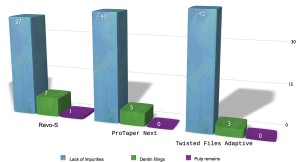
The shape of an instrument’s cross-section is another important factor that modulates suitability for cleaning of recesses. The more protruding the cutting edges of an instrument are, the more effecting side machining is. Tools of an asymmetrical cross-section, theoretically, should have an advantage in the brushing technique. Based on this experiment it seems that the efficiency of an instrument in this aspect is not linked with the asymmetry, but with the shape of the instrument’s cross-section and the number of active cutting edges.
FIGURE 2. Percentage share of the level of cleanliness of irregular canals using the examined instruments.

Each of the instruments examined is characterised by a different cross-section. Twisted Files have a triangular cross-section with sharp edges. The cross-section of Revo-S instruments resembles the shape of a windmill (a triangle with concavo-convex sides), and the cross-section of ProTaper instruments is rectangular. The more favourable effects achieved with ProTaper Next instruments, in comparison to Revo-S, result from the fact that in the case of ProTaper Next the walls of a canal are machined by two cutting edges and in Revo-S by only one. Twisted Files Adaptive instruments machine dentin with all three edges.
FIGURE 3. Percentage share of the level of cleanliness of oval canals using the examined instruments.

In the authors’ study, irrespective of the shape of cross-sections and the distance from the apex, the most favourable effects were achieved with Twisted Files Adaptive instruments. It needs to be underlined that in the apical part the highest effectiveness was obtained with ProTaper Next. Moreover, the ProTaper Next system made it possible to achieve much better results in comparison to ProTaper Universal, which had been studied by the author’s earlier.4
In this experiment, despite the random division of dental roots, the distribution of experimental material in particular groups was not homogeneous in terms of quality. It should be mentioned that the shape of cross-sections of the root canals was evaluated after, not before, mechanical preparation. In natural conditions, canals with round cross-sections occur very rarely. Only after mechanical preparation the shape of their cross-section can be made round, which is possible in canals with regular shape and insignificant degree of ovality. In the canals of a clearly oval or irregular shape of the cross-section, it is also possible to achieve an oval or irregular shape as a result of instrumentation (despite widening). In groups 1 and 2 (Revo-S and ProTaper Next, respectively), the most regular round shape of the cross-section was found almost in 50% of the samples. Perhaps this fact was conducive to more favourable results in the apical part when using the ProTaper Next system (10 round canals and 5 oval canals) in relation to Twisted Files Adaptive (7 round, 6 oval and 2 irregular canals). In spite of a bigger frequency of oval and irregular canals in group 3 (Twisted Files Adaptive), the best results were recorded globally in this group. It is perhaps possible to draw a conclusion that Twisted Files Adaptive are effective in cleaning canals prepared using the brushing technique.
FIGURE 4. Model cross-sections of the root canals prepared using Revo-S rotary system: a) clean canal, b) canal polluted with pulp remains.

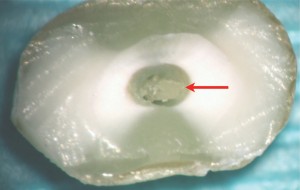
FIGURE 5. Model cross-sections of the root canals prepared using Revo-S rotary system: a) clean canal, b) canal polluted with pulp remains.


FIGURE 6. Model cross-sections of the root canals prepared using Twisted Files Adaptive instruments: a) clean canal, b) canal polluted with dentin filings.

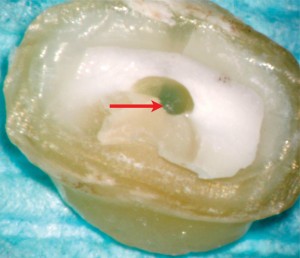
Due to the limitations of this experiment, it is necessary to conduct further studies to evaluate fully the suitability of the examined instruments.
Conclusions
On the basis of the study carried out it is possible to determine that the canals in which, as a result of preparation, a round cross-section was obtained were prepared effectively (without leaving any filings and residues) using all the examined instruments. All of the studied systems of rotary instruments were characterised by a similar degree of canal cleaning. Insignificant differences can be summarized in the following points:
1. Regardless of the shape of a cross-section and part of a dental root, better results were obtained with Twisted Files Adaptive instruments (p = 0.26).
2. In the apical part of the examined root canals the highest degree of cleanliness was recorded in the canals prepared using ProTaper Next instruments (p = 0.057).
3. In both the middle and coronal part, the most favourable effects were achieved with Twisted Files Adaptive instruments (pm = 0.31 and pc = 0.76). OH
Oral Health welcomes this original article.
References
1. Friedman S., Abitbol S., Lawrence H.P.: Treatment outcome in endodontics: The Toronto study. Phase 1: initial treatment. J. Endod., 2003, 29, 12: 787–793.
2. Krupiński J.: Metody i zasady leczenia endodontycznego. Część VII. Opracowanie kanałów korzeniowych instrumentami niklowo-tytanowymi maszynowymi. Poradnik Stomatol., 2003, 4: 10–18.
3. Wilkoński W. et al.: Porównanie opracowania kanałów korzeniowych za pomocą systemów rotacyjnych Mtwo i EndoWave oraz nowego systemu SAF – badanie in vitro. Mag. Stomatol., 2010, 222, 11: 82–94.
4. Wilkoński W. et al.: Analiza porównawcza jakości opracowania kanałów korzeniowych za pomocą systemów rotacyjnych ProTaper i Mtwo oraz systemu recyprokalnego Reciproc – badanie in vitro. Poradnik Stomatol., 2011; 9: 340–347.
5. Thompson S.A.: An overview of nickel-titanium alloys used in dentistry. Int. Endod. J., 2000, 33: 297–310.
6. Gambarini G. et al.: Fatigue resistance of engine-driven rotary nickel-titanium instruments produced by new manufacturing methods. J. Endod., 2008, 34, 8: 1003–1005.
7. Al-Hadlaq S.M., Aljarbou F.A., Al Thumairy R.I.: Evaluation of cyclic flexural fatigue of M-wire nickel-titanium rotary instruments. J. Endod., 2010, 36, 2: 305–307.
8. Yared G.: Canal preparation using only one Ni-Ti rotary instrument: preliminary observations. Int. Endod. J., 2008, 41, 4: 339–344.
9. Hilfer P.B. et al.: Multiple autoclave cycle effects on cyclic fatigue of nickel-titanium rotary files produced by new manufacturing methods. J. Endod., 2011, 37, 1: 72–74.
10. Valois C.R., Silva L.P., Azevedo R.B.: Multiple autoclave cycles affect the surface of rotary nickel-titanium files: an atomic force microscopy study.
J. Endod., 2008, 34, 7: 859–862.
11. O’Hoy P.Y., Messer H.H., Palamara J.E.: The effect of cleaning procedures on fracture properties and corrosion of NiTi files. Int. Endod. J., 2003, 36, 11: 724–732.
12. Sonntag D., Peters O.A.: Effect of prion decontamination protocols on nickel-titanium rotary surfaces. J. Endod., 2007, 33, 4: 442–446.
13. De-Deus G. et al.: Extended cyclic fatigue life of F2 ProTaper instruments used in reciprocating movement. Int. Endod. J., 2010, 43, 12: 1063–1068.
14. You S.Y. et al.: Lifespan of one nickel-titanium rotary file with reciprocating motion in curved root canals. J. Endod., 2010, 36, 12: 1991–1994.
RELATED ARTICLE: Histobacteriology Of Teeth With Failed Root Canal Treatment – A Pilot Study












